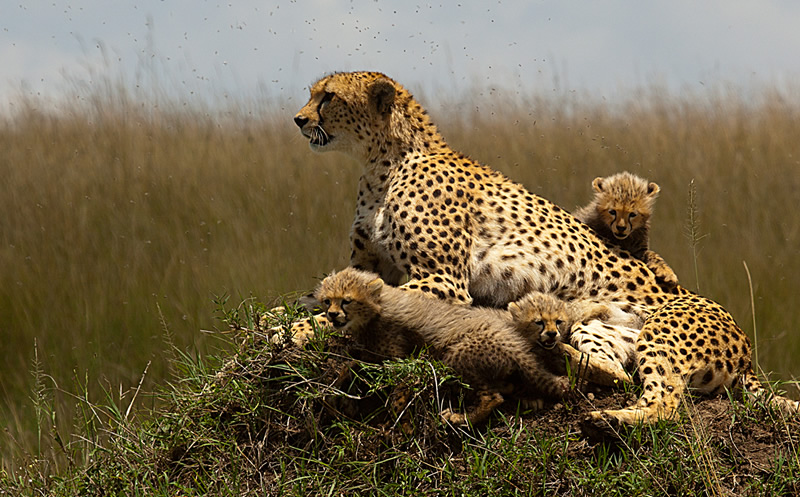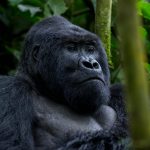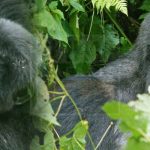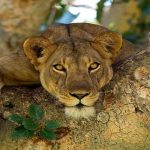If all you know of wild Africa is David Attenborough or Big Cat Diary you are in for the surprise of your life. No matter how many wildlife documentaries you may have watched, nothing prepares you for the real thing.
I still remember my own first visit, flying by light aircraft from Nairobi down to the Maasai Mara. Below me lay a sea of grass in which elephants stood and shook their ears as we zoomed overhead. With mounting excitement I picked out more animals: graceful giraffes, lines of wildebeest strung out like beads across the savannah. “Look down there,” yelled the pilot, jabbing his finger at a flat-roofed thorn tree. In its shade lay five tawny cats: my first lions.
A safari holiday should be on everyone’s wish list of life’s greatest adventures. In Swahili, the melodious everyday language of East Africa, the word itself translates as “going on a journey”. In the age of Hemingway and Karen Blixen this meant going upcountry, setting off with a tent and a rifle into the back of beyond where the wild things are. Now the day of the hunter is done. Guns are out. Cameras are in and ecotourism is the buzzword in the bush, offering a gentler but no less thrilling introduction to the last place on earth where wildlife exists in its old abundance.
But the reasons for going on safari have not changed. The need to reach out and touch the wild, to spend time in the sun and under the stars and come face to face with Africa’s storybook animals, not behind bars but moving free as the wind across the savannah – these are what make this a holiday like no other.
So where should you go for your first taste of safari life? Africa is so vast, its horizons so wide. Some of its big-game strongholds are the size of small countries. Among the finest are Botswana’s Okavango Delta, Zambia’s Luangwa Valley and South Africa’s Kruger National Park. But if you are planning a once-in-a-lifetime sojourn in the bush it has to be East Africa. Nowhere are animals so visible as on the high plains of the Maasai Mara and Serengeti, and the land itself is quite something. To look down into the immense bowl of the Ngorongoro Crater is to stand at the gates of heaven.
Ease of access makes East Africa a natural favourite for first-timers. It takes only eight hours to fly from London to Nairobi. If you catch an overnight flight from Heathrow you can transfer to a light aircraft next morning and be in the bush in time for brunch. Such things are possible in Nairobi because Kenya’s safari industry is backed up by an efficient tourist infrastructure with a dazzling choice of camps and lodges to suit all budgets. This is, after all, where modern safaris were invented back in the Twenties.
Ways to go
On a budget
Travelling by road helps keep the cost down and is a good way of seeing more of Africa. Journeys between parks average around five hours and the usual mode of transport is the ubiquitous eight-seater VW Kombi minivan with raised roof hatches for better game viewing. You will have a local English-speaking driver-guide. Thomson Holidays (0844 050 2828; thomsonworldwide.com) offers an eight-day Kenya Classic Safari from £1,679 per person, visiting the Maasai Mara, Lake Nakuru and Amboseli and including return flight to Nairobi with Kenya Airways.
In style
Going upmarket opens up all kinds of possibilities, including direct flights into the bush by light aircraft that cut out long road journeys, game drives with expert local guides in open four-wheel-drive vehicles purpose-built for better viewing, and the opportunity to stay at Africa’s most exclusive luxury camps and lodges. Safari Consultants (01787 888590; safari-consultants.co.uk) can arrange a 10-day Kenyan holiday with three nights at Elsa’s Kopje Lodge in Meru National Park and four nights at Mara Toto Camp in the Maasai Mara including return flight from London and all local flights and transfers from £4,765 per person. Alternatively, Tanzania Odyssey (020 7471 8780; tanzaniaodyssey.com) can put together an eight-day Tanzanian safari, including two nights at Ngorongoro Crater Lodge and four nights at Nomad’s Lamai Camp in the northern Serengeti, from £3,275 plus £850 for flights from London to Kilimanjaro with Kenya Airways .

Kenya’s most popular safari destination is the Maasai Mara National Reserve, where you are likely to see lions. Photo: Alamy
Mobile camping
This is the most authentic way to see Africa at close hand without sacrificing too many creature comforts, and it gives you greater flexibility in the bush. Wild About Africa (020 8758 4717 ; wildaboutafrica.com) recommends a 10-day Tanzanian camping safari (seven nights in the bush) to Tarangire, Lake Manyara, Ngorongoro Crater and Serengeti. This is a group trip designed for a maximum of 14 people travelling in two four-wheel-drive Land Cruisers). Prices start at £3,174 per person based on two people sharing and include return flight from London.
Walking
Here’s a real one-off adventure for anyone who is reasonably fit. You may not get such good wildlife photo opportunities as you would from a vehicle, but only on foot will you experience the full-on thrill of wild Africa. Audley Travel (01993 838510; audleytravel.com) does a five-night walking safari in northern Kenya’s spectacular Karisia Hills from £3,830 per person, including return flight to Nairobi and all transfers. The safari is supported by riding camels and accompanied by Samburu guides.
Beach-and-bush safaris
An irresistible combination: a sojourn in Big Five country followed by a chance to relax beside the Indian Ocean. The Ultimate Travel Company (020 3051 8089; theultimatetravelcompany.co.uk) has a 10-day holiday with four nights on safari at Little Governor’s Camp in the Maasai Mara and five nights on Zanzibar’s east coast, staying at the Baraza Resort and Spa, part of the Zanzibar Collection (thezanzibarcollection.com) . The cost is from £3,750 per person, including meals, game drives and transfers, return flight from London with Kenya Airways, bush flights and connections to Zanzibar.
Tailor-made
Travelling with a professional guide can make a world of difference to your holiday. The elite few at the top of their game can charge up to £1,000 per day, but it doesn’t have to cost you the earth. Abercrombie & Kent (0845 4851141; abercrombiekent.co.uk) can arrange a tailor-made Kenyan safari with experienced bush-wise guides such as Andrew Francombe at Ol Malo and Joseph Chege at Amboseli. Seven days in Kenya with A&K, including two nights at Ol Malo in Laikipia, two nights at Tortilis Camp in Amboseli and two nights in the Maasai Mara, costs from £4,365 per person, including economy return flight and transfers.
Alternatively, Africa Travel Company (020 7843 3586; africatravel.co.uk) is offering three nights at Elsa’s Kopje in Meru National Park and four nights in the Maasai Mara at Cottars 1920 Safari Camp with the services of a professional guide throughout. The cost is from £6,095 per person based on travelling in June and includes BA flights from London, local flights to Meru and the Mara, all transfers and one night at the Palecina Hotel in Nairobi.
The Maasai Mara and the Serengeti make for the ultimate safari experience
Where to go
Kenya’s most popular safari destination is the Maasai Mara National Reserve. This is where the BBC’s Big Cat Diary was filmed, and there is nowhere better for close encounters with lions, cheetahs and leopards. Travel between July and October to see the wildebeest migration, the greatest wildlife show on earth. Very different are the dry country parks of northern Kenya. Samburu is renowned for elephants, Meru was the home of Elsa, the Born Free lioness, and Lake Nakuru National Park is a showcase for flamingos and rhinos. Tsavo is so big it is split into two parks, Tsavo East and Tsavo West, and combines well with a trip to Kenya’s glorious Indian Ocean coast. Also well worth considering are Laikipia, Amboseli and the Chyulu Hills.
Tanzania welcomes visitors with wonderful views of Kilimanjaro, Africa’s highest mountain (19,000ft). Kilimanjaro airport or nearby Arusha town are the main departure points serving the northern safari circuit by road and air. Allow a full day to explore Lake Manyara National Park and at least another for the Ngorongoro Crater before setting foot in the Serengeti. This park is huge (think of an area the size of Wales), so you need to plan carefully if you want to see the migration (see below). Afterwards, where better to relax than Zanzibar with its coral-sand beaches and barefoot beach lodges?
When to go
The most popular time is in the dry season from June to October. But be aware that our midsummer is the African winter and you will need warm clothes for dawn game drives. April and May are best avoided: this is the climax of East Africa’s rainy season, when bush roads become impassable and camps close down.
To be sure of seeing the annual wildebeest migration, head for Kenya’s Maasai Mara reserve between July and October when the herds spend the dry season crossing and recrossing the Mara River in their search for fresh grazing. As a spectacle it is matched only when upwards of a million wildebeest and 250,000 zebras gather on the rain-soaked plains of the southern Serengeti to give birth in February.
Health
For online advice, consult Fit For Travel (fitfortravel.nhs.uk) or NATHNAC (nathnac.org), which is used by GPs to assess health risks abroad. Make sure your immunisations are up to date, specifically for hepatitis A, typhoid, diphtheria and tetanus. Malaria is widespread, so antimalarial tablets are essential, and immunisation against yellow fever is recommended. An insect repellent containing DEET will help keep mosquitoes at bay. Drink only bottled water, which is available at all camps and lodges.
For peace of mind you may wish to consider signing up to membership of AMREF (amref.org), the flying-doctor service that provides evacuation in medical emergencies. A month’s subscription costs $16 (about £10) and is valid from the day you arrive in east Africa.
Visas
A single-entry tourist visa for Kenya costs around £30 . It is valid for three months from the day of entry and can be obtained when going through customs at Jomo Kenyatta airport in Nairobi. A 90-day single-entry tourist visa for Tanzania costs £40 and can be obtained when going through customs at Kilimanjaro airport or Dar es Salaam.
Alternatively, you can use a visa agent. Trailfinders’ Visa and Passport Service (0845 050 5905; visas.trailfinders.com) charges £65 for a Kenyan visa and the same for a Tanzanian one (£45 if you have booked your trip with them), and the process takes about five working days.
Money matters
American dollars are the universal currency wherever you go, although notes printed before 1996 are sometimes not accepted and $100 bills can be difficult to change; better to take plenty of small ones. Nowadays most camps and lodges accept credit cards such as Visa and Mastercard, but expect a surcharge of up to five per cent.
How to dress
Always put comfort and practicality ahead of style. Never wear white, and avoid bright colours. Instead, be a chameleon and blend into the landscape with animal-friendly greens and khakis. Never dress in camouflage clothing (associated with the military) or anything black or blue (both colours are known to attract tsetse flies).
Go for lightweight cottons, long trousers and shirts with long sleeves to protect against thorns and insect bites. Eschew fancy stetsons with faux leopard-skin hatbands in favour of a simple baseball cap that keeps the sun out of your eyes and does not blow away in a strong wind.
Wear sensible footwear with thorn-proof soles: desert boots, trainers or lightweight walking boots. Don’t forget your swimwear (many camps and lodges have pools). And remember, Africa can be cold. The Maasai Mara may be within 100 miles of the Equator but is more than 5,000ft above sea level. On dawn game drives you’ll be glad of a jacket and sweater, even gloves. Most camps and lodges have a shop where you can buy a cotton kikoi, an African sarong that can double as a scarf, sling or turban.

Expert advice: don’t attempt to sit on top of your safari vehicle. Photo: Alamy
What else to pack
Binoculars are a must. So is a camera. I always take P20 last-all-day sun cream, sunglasses and a head torch. Use a soft bag and travel light. Local flights in light aircraft often have a 15kg weight limit. Most camps and lodges offer same-day laundry (although washing ladies’ underwear is taboo).
Flights
British Airways (0844 493 0787; britishairways.com) and Kenya Airways (0871 989 1198; kenya-airways.com) both fly non-stop from Heathrow to Nairobi in about eight hours. Flying overnight avoids the expense of a hotel stopover in Nairobi. Instead you transfer across town from Jomo Kenyatta International Airport to Wilson Airport for a short internal flight by light aircraft and are in camp by late morning. To reach Tanzania’s northern safari circuit involves an hour’s onward flight from Nairobi to Kilimanjaro with Kenya Airways or Precision Air (0844 482 2313; precisionair.co.uk) to link up with light-aircraft flights into the game parks.
Safety in the bush
Follow these 10 rules and you’ll be safer in the bush than in any major city.
1. Always listen to your guide.
2. Zip up your tent and never take food into it.
3. When out on a game drive remember that animals are used to vehicles; but don’t be noisy or make sudden movements.
4. Stay inside the vehicle (ask your driver or guide if you need to make a “bush stop”).
5. Don’t sit on the roof. It’s not cool – it’s stupid.
6. Watch out for thorns and overhanging branches when driving.
7. If you’re on foot, don’t run. Only prey animals run!
8. Don’t mess with baboons.
9. Obey the safety rules in your camp or lodge.
10. Don’t walk around at night and make sure you are escorted back to your tent or room after dinner.
Creepy-crawlies
East Africa has lots of scorpions and snakes, including puff adders, cobras and mambas. Fortunately they are so keen to avoid you that you seldom see them. Just be aware and take simple precautions such as not walking at night without a torch. Mosquito nets are provided when needed, and you should find a spray can in your tent for zapping bugs.

Opulence at Baraza Resort and Spa in Zanzibar, which allows you to mix the beach with the bush.
A room with a view
The camps and lodges where you stay are set in the heart of the action, and all have been chosen for their idyllic locations. If you are new to Africa, you may feel happier staying in a lodge, although you’ll be every bit as safe zipped up in a tent. Lodges are permanent structures, bush hotels if you like, complete with swimming pools and ingeniously fashioned out of local stone and timber under a thatched roof.
But sleeping under canvas is the way to go if you want to enjoy the full-on safari experience. When it comes to tented camps, size matters. Large tented camps are more like canvas lodges. The smaller and more intimate the camp, the better the experience – and the more expensive it is likely to be. Your canvas room with a view could cost more than a suite in a five-star hotel.
Not that you’ll be exactly roughing it. Everything is provided, from en suite bathrooms to Persian rugs, even hot-water bottles for chilly nights. But the ultimate luxury comes from living closer to nature without compromising your safety.
Reading
Get in the mood with Karen Blixen’s classic Out of Africa, and I Dreamed of Africa by Kuki Gallmann. Other East African true‑life epics include My Pride and Joy by George Adamson, the Born Free lion man of Kenya, and Among the Elephants by Iain and Oria Douglas-Hamilton.
Guidebooks
The Safari Companion by Richard D Estes (Chelsea Green Publishing, $30/£18) is an invaluable guide to watching African mammals. If you are short of space, take the beautifully illustrated Kingdon Pocket Guide to African Mammals by Jonathan Kingdon (Christopher Helm, £16.99). For general guides, choose Bradt Travel’s Kenya and the companion volume on Northern Tanzania, both written by Philip Bragg.
Websites
The most comprehensive online resource available is Safaribookings.co.uk/experts. To find out about wildlife conservation go to tusk.org, the website of the Tusk Trust. Living with Lions (lionconservation.org) will update you on attempts to protect Kenya’s top cats, and Save the Elephants (savetheelephants.org) is for everyone who wants to put an end to ivory poaching.
The Big Five and other animals
It was the old-time trophy hunters who called Africa’s most dangerous game the Big Five: elephant, Cape buffalo, rhino, lion and leopard. Today, with other charismatic species such as cheetah and the endangered wild dog, they sit at the top of most must-see lists. The big cats can be elusive and half the fun is searching for them. Antelopes, zebras and giraffes are more abundant and just as beautiful. Don’t forget the birds, at least 1,000 species, or the “Small Five” (buffalo weaver, elephant shrew, ant lion, rhino beetle and leopard tortoise).
A typical day on safari
“Knock-knock,” says the man outside your tent with a tea tray in his hands. What kind of holiday is this, you might ask, being woken at 6am? But sunrise in Africa is not to be missed. Where else can you sit in bed and hear lions roar at the dawn?
In Africa, the first and last hours of the day are the best, and the early start is so you can be out in the bush while the big cats are still active. Later, when the day warms up, they will go flat in the shade, and so can you on returning to camp for brunch after your first game drive of the day.
There’ll be plenty of time for a swim or siesta before afternoon tea and cakes (no one goes hungry on safari), after which you drive out again, camera at the ready, in search of the Big Five. In the national parks you’ll be home by sunset, but on private reserves you can stay out for sundowners and drive home in the dark with a spotlight looking for nocturnal animals.








